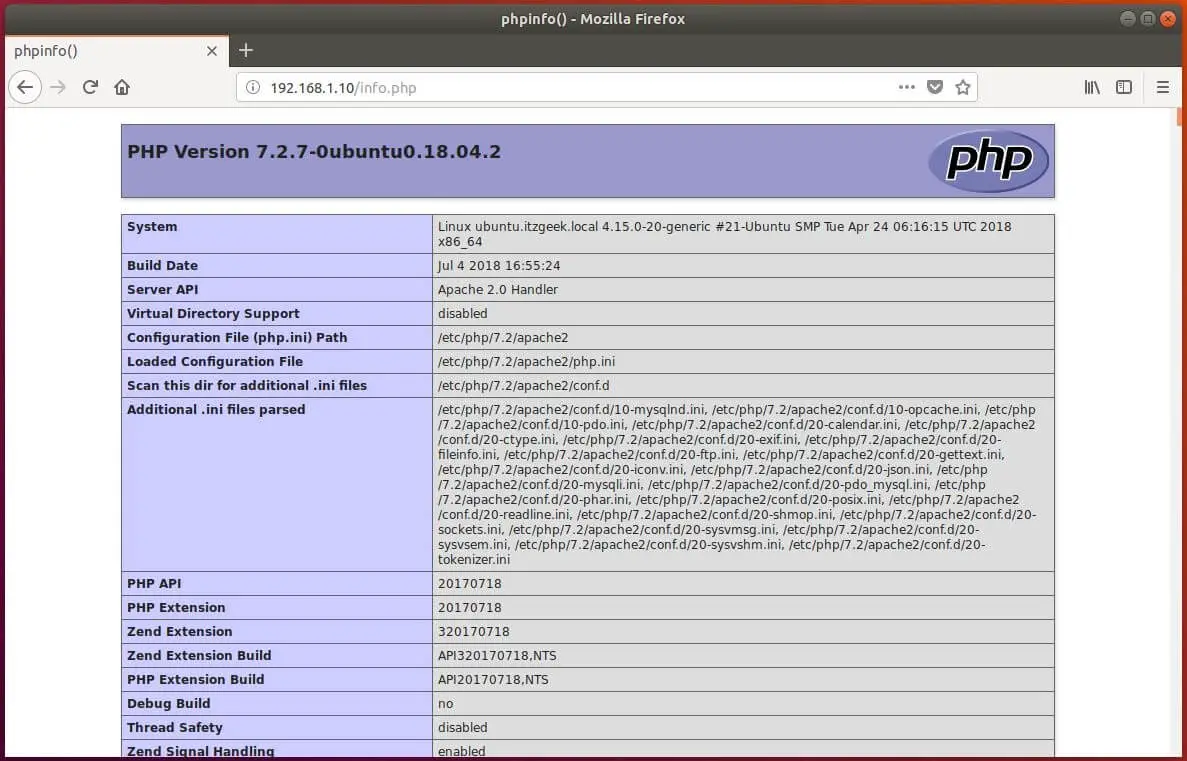Install Mariadb Ubuntu 18.04
Stack (, and ) is the widely used stack to host a simple to large websites. If you think the above combination will only be installed on servers where the hosting is made, then that is wrong you can setup stamp on your PC which has Linux.The installation procedure of the on is quite simple when compared to other environment.In other environment, you need to install packages separately, one by one. But in, you can install the whole stack in the single command.Here, we will see both ways of installing on. You would get MySQL 5.7 as a database when you install LAMP stack using the single command. But, at the same time, if you choose to install LAMP stack manually, then you will be guided to install MariaDB 10.1 as a database. Install LinuxHere is the guide about the. Install LAMP Stack on Ubuntu 18.04 – Manual (One by one)Now, we will proceed to install AMP (Apache version 2.4, PHP version 7.2, MariaDB version 10.1) on Ubuntu 18.04.
- Install MariaDB The next step is to install MariaDB as the database handler. Akaunting is a program that handles a lot of information so it is necessary to store it in a database and MariaDB stands out for its robustness, simplicity of use and above all reliability.
- Install Apache, MariaDB, PHP (LAMP stack) In Ubuntu 18.04 LTS Server by sk Published July 6, 2018 Updated February 6, 2019 As you may know already, LAMP stack is a popular, open source web development platform that can be used to run and deploy dynamic websites and web-based applications.
The second part of our LAMP tutorial series: how to install MySQL (or MariaDB) on an Ubuntu server. This tutorial is intended for Ubuntu servers, the instructions should work on any LTS release of Ubuntu, including Ubuntu 14.04, Ubuntu 16.04, Ubuntu 18.04, even non-LTS releases like Ubuntu 17.10 and other Ubuntu-based distros.We tested this on an Ubuntu 16.04 server.
Install Apache HTTP serverUpdate the package repository index. Sudo apt updateInstall apache2 package using the apt command. Sudo apt -y install apache2Testing Apache HTTP server:We will now test the Apache web server to confirm whether it is working correctly. Open up any web and then navigate it to the following URL. Will get the “ Apache2 Ubuntu Default Page“, and this default page confirms you that the Apache HTTP server is working fine. Install LAMP stack on Ubuntu 18.04 – Apache Test PageApache web server’s default document root is /var/www/html/ on Ubuntu and the main configuration file is /etc/apache2/apache2.conf. Additional configuration files can be found in the /etc/apache2/.enabled directory.The directory hierarchy as follows.
/etc/apache2/ - apache2.conf `- ports.conf - mods-enabled -.load `-.conf - conf-enabled `-.conf`- sites-enabled`-.conf Install MariaDB Serverhas replaced as a default database server in Linux distribution. To install MariaDB, run the following command sudo apt -y install mariadb-server.
Install PHPBy default Apache server supports the.html only, not. To get a PHP supprt, you would need to install PHP and the PHP extension package for MariaDB.Here, we will install PHP 7.2 on Ubuntu 18.04. Sudo apt -y install php php-mysqlRestart the Apache HTTP server after the installation of the PHP package. Sudo systemctl restart apache2Now, skip to.
Install Mariadb Ubuntu 18.04 64

Install LAMP Stack on Ubuntu 18.04 – Single CommandNow, we will proceed to install AMP (Apache version 2.4, PHP version 7.2, MySQL 5.7) on Ubuntu 18.04.Update the repository cache using the apt command. Sudo apt updatePaste below the line in the terminal and hit enter. Sudo apt install lamp-server^The above command will search and install the required packages for LAMP server. You should see messages something like below. Install LAMP stack on Ubuntu 18.04 – Install LAMP Stack in Single Command on Ubuntu 18.04Wait for 10 to 15 minutes to let the installation LAMP stack complete.

Should get the following page, and this confirms that Apache web server is working fine. Install LAMP stack on Ubuntu 18.04 – Apache Default PageApache’s default document root is /var/www/html on Ubuntu, and the main configuration file is / etc/apache2/apache2.conf.Additional configurations like Virtual hosts and modules can be found in /etc/apache2/.-enabled directory Test LAMP StackFor testing the PHP, we will place one PHP file on to the default document root of Apache. Sudo nano /var/www/html/info.phpPaste the below line into the info file: Now open a web browser and type the following into the web address.
I run the following and get these error messages: sudo apt updatesudo apt upgradesudo apt install mariadb-server mariadb-clientConfiguration file '/etc/mysql/debian-start' Deleted (by you or by a script) since installation. Package distributor has shipped an updated version.
What would you like to do about it? Your options are:Y or I: install the package maintainer's versionN or O: keep your currently-installed versionD: show the differences between the versionsZ: start a shell to examine the situation The default action is to keep your current version.(I chose 'I') Installing new version of config file /etc/mysql/debian-start. Dpkg: error processing package mariadb-server-10.1 (-configure): installed mariadb-server-10.1 package post-installation script subprocess returned error exit status 1 dpkg: dependency problems prevent configuration of mariadb-server: mariadb-server depends on mariadb-server-10.1 (= 1:10.1.29-6); however: Package mariadb-server-10.1 is not configured yet.dpkg: error processing package mariadb-server (-configure): dependency problems - leaving unconfigured Processing triggers for libc-bin (2.27-3ubuntu1). No apport report written because the error message indicates its a followup error from a previous failure.Processing triggers for ureadahead (0.100.0-20). Processing triggers for systemd (237-3ubuntu10). Errors were encountered while processing: mariadb-server-10.1 mariadb-server E: Sub-process /usr/bin/dpkg returned an error code (1)I've also tried installing mysql and have other problems.
I read that mariadb is now preferred. What's wrong? Everything else on this installation works perfectly, but so far I haven't been able to get this to work.